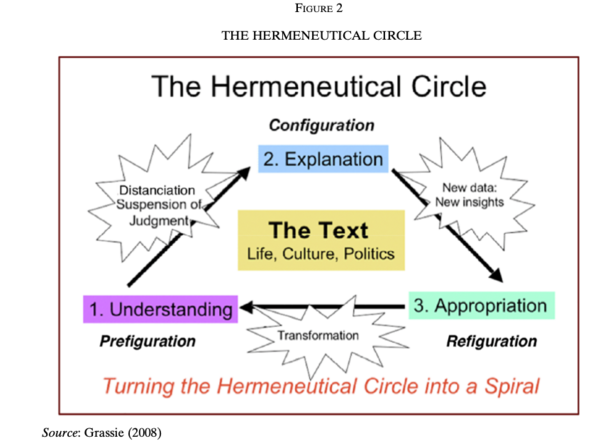Difference between revisions of "Hermeneutics"
Jump to navigation
Jump to search
m |
|||
| Line 4: | Line 4: | ||
This idea was also mentioned in the book<ref>{{:Book/Algebraic Models for Accounting Systems}} Section 1.7 Accounting and Formal Langauges, Page 19</ref>: [[Book/Algebraic Models for Accounting Systems|Algebraic Models for Accounting Systems]]. | This idea was also mentioned in the book<ref>{{:Book/Algebraic Models for Accounting Systems}} Section 1.7 Accounting and Formal Langauges, Page 19</ref>: [[Book/Algebraic Models for Accounting Systems|Algebraic Models for Accounting Systems]]. | ||
<noinclude> | <noinclude> | ||
{{PagePostfix | |||
= | |category_csd=Abstract Interpretation, Compiler Theory, Formal Language | ||
}} | |||
</noinclude> | </noinclude> | ||
Revision as of 02:03, 30 June 2022
Hermeneutics(Q102686) is the theory and practice of text interpretation.
Hermeneutic Circle
Hermeneutic circle(Q1570095) is the recursive structure that represent the iterative nature of interpretation.
Note the three stages in the following diagram[1]:
- Configuration
- Refiguration
- Prefiguration
This idea was also mentioned in the book[2]: Algebraic Models for Accounting Systems.
References
- ↑ Sangster, Alan (2021). "The Life and Works of Luca Pacioli (1446/7–1517), Humanist Educator". Abacus: A Journal of Accounting, Finance and Business Studies. local page: University of Sydney. 57. , Figure 2
- ↑ Rambaud, Salvador Cruz; Pérez, José García; Nehmer, Robert A.; Robinson, Derek J S Robinson (2010). Algebraic Models for Accounting Systems. local page: Cambridge at the University Press. ISBN 978-981-4287-11-1. Section 1.7 Accounting and Formal Langauges, Page 19
Related Pages
